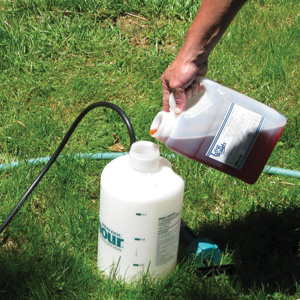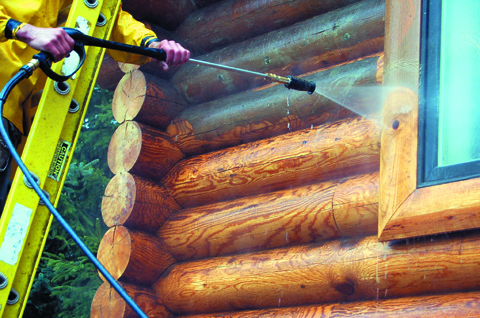Log homes are strong, sturdy, and beautiful, but, like all homes, they are also vulnerable. Constantly under attack from the elements, pests, and other threats, these homes require regular cleaning with products that address those intrusions and preserve the beauty of the logs. Selecting the appropriate cleaner is the first step in the right direction, according to Barbara Murray, president of CTA Products Group in Southaven, Mississippi, who points out that the cleaning needn’t always be invasive, but it does need to happen on a regular schedule (preferably on an annual basis).
Sean Gahan, senior chemist at Redmond, Washington-based Perma-Chink Systems, Inc., says picking the right cleaner is important because it will help extend the longevity of the log’s finish and stain. “Removing all of the foreign matter that builds up over the course of the year is important,” says Gahan, who recommends annual cleanings. “That matter sits on the surface of the wood and traps moisture and debris close to the coating and/or finish system. When it’s not removed that debris will degrade the finish.”
Look First at the Finishes
Murray says the finishes and/or coatings that were applied to the log will ultimately determine which cleaner will be most effective. Any cleaning is meant to gently remove dirt and grime from the surface of the log, says Murray, although certain coatings may require different levels of attention. “Before you do your first cleaning, talk to your log home producer about exactly what’s on the logs,” says Murray. “Then use that information to make the best decision about your cleaner.”
Unfortunately, Gahan says many log home owners ignore the need for periodic cleanings and instead wait until the last possible minute—when, say, mold becomes visible on the logs—to do the annual task. “It’s not like washing a car, which you can knock out at the carwash in 10 minutes once a week,” says Gahan, who estimates that just one-third of log home owners wash their homes regularly. “The time put into cleaning your log home pays off. A periodic cleaning makes the home look better and last longer and gives the logs a nice luster.”
Gahan recommends low-pH or low-acidic cleaners, both of which tend to be “more forgiving to the finish” compared to a high-pH or an alkaline option. The cleaners typically come in a concentrated form that gets diluted in water prior to use. “Leave the solution on for 20 to 30 minutes and use a soft bristle brush to loosen the debris that’s in the dirtier areas,” Gahan says. “Move
from bottom to top when applying the cleaner and then from top to bottom when rinsing.”
One question that comes up often in relation to log homes is whether or not it is safe and effective to use chlorine bleach as a
cleaning product. Gahan says that Perma-Chink’s own research has shown that the product is not a good choice for cleaning wood and existing finishes. “Along with its potential for damaging the finish and bare wood fibers,” says Gahan, “bleach’s use
and misuse contributes to a number of problems including the loss of film adhesion, discolorations due to tannin extraction, and the formation of iron tannates, streaks, blotches, and premature failures of the finish system.”
Follow the Labels
Once you’ve selected a cleaner, be sure to read and follow the directions on the label. One may recommend annual washings, for example, another may boast that it “rinses off easily,” and another may require pressure washing. “All of the products are not the same; there are different chemistries out there on the market,” says Murray. “Read the labels carefully and match the product to your finish and you won’t go wrong.”
Cleaning day is also a great time to inspect the logs and ensure that no new intrusions or problems have surfaced during the prior 12 months. “This allows you to be proactive with your maintenance,” says Gahan. Check for spots that get darker when sprayed with water (a sign that the coating is breaking down and letting water in) and areas where mold may be growing. “Make a punch list of the short-term and long-term issues to keep an eye on,” says Gahan, “and pull it out every year to double check that no new problems have come up.”



